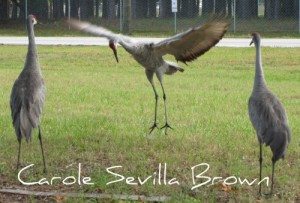I’ve been in Florida for the past several weeks taking care of my mom who is quite ill.
One thing I’ve learned from Susan J. Tweit about this process is that it’s really important to find the beauty of nature around me each day. In this way I am able to find some peace and solace and renew my own spirits.
Yesterday on the way to the hospital, I noticed a very large bird in the front yard of someone’s home. It took a few seconds for it to sink in that this was NOT a Great Blue Heron as I originally thought, this was a Sandhill Crane! I made a Uturn and pulled the car over by the side of the road, only to see that there was a whole group of these beautiful birds hanging out in someone’s garden.
As I watched I was filled with joy to see them playing and performing a beautiful dance. One would pick up a small branch with several leaves on it and toss it into the air. Others would join in and try to grab the branch so they could toss it, too.
They appeared to be playing, and it was so much fun to watch them!
The Sandhill Crane, scientifically known as Antigone canadensis, is a bird native to North America that is known for its striking physical characteristics. It is a large bird, with a height of up to five feet and a wingspan of up to seven feet. It has a gray body, a red crown, and a long, slender neck, which sets it apart from other birds. Additionally, its distinctive calls, a series of trumpeting honks, can be heard from far away.
Sandhill Cranes are migratory birds and travel thousands of miles every year between their breeding grounds in the northern United States and Canada and their wintering grounds in the southern United States, Mexico, and Central America. They feed on a diverse diet, which includes plants such as grains, seeds, and roots, as well as insects, snails, and small mammals. The birds use their long bills to probe for food in the mud and shallow water.
Sandhill Cranes are also known for their spectacular mating dances, which involve leaping and bowing, and the calls they make during these displays. They lay their eggs in a nest made of sticks, which they build on the ground in a shallow wetland or marsh.
Although the Sandhill Crane is considered a species of least concern by the International Union for Conservation of Nature (IUCN), some populations are declining due to habitat loss and hunting. To protect and conserve these birds and their habitats, conservation efforts are being undertaken.
More From Ecosystem Gardening:
Submit your review | |








